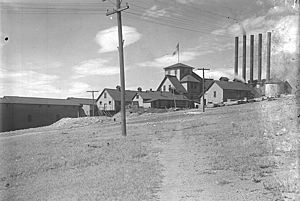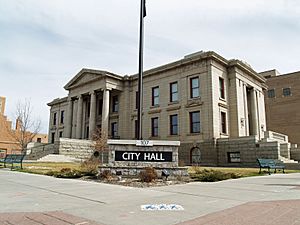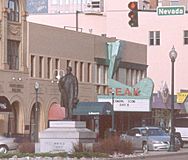Winfield Scott Stratton facts for kids
Quick facts for kids
Winfield Scott Stratton
|
|
|---|---|
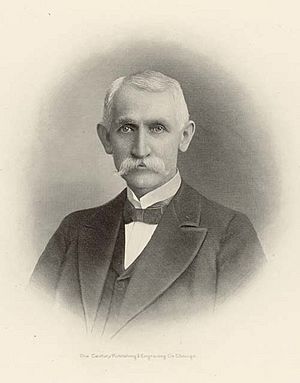
Stratton, 1901
|
|
| Born | July 22, 1848 |
| Died | September 14, 1902 (aged 54) |
| Occupation | Prospector, philanthropist |
| Known for | First millionaire from the Cripple Creek Mining District boom. |
| Spouse(s) | Zeurah Stewart (divorced) |
| Relatives | Harry Stratton (son) |
Winfield Scott Stratton (born July 22, 1848 – died September 14, 1902) was an American prospector, businessman, and philanthropist. He found the Independence gold mine near Victor, Colorado on July 4, 1891. By 1894, he became the first millionaire from the Cripple Creek Mining District. Stratton used his wealth to help build many important places and improve public services.
Contents
Early Life and Learning
Winfield Scott Stratton was born in Jeffersonville, Indiana, on July 22, 1848. His parents were Mary and Myron Stratton. He was one of their twelve children. It is believed he was the only boy who lived past childhood.
Education and Skills
Stratton learned carpentry from his father, who worked in shipyards. After moving to Colorado, he continued his education. He studied rocks and the Earth (called geology) at Colorado College. He also learned about how to get metals from rocks (called metallurgy) at the Colorado School of Mines in 1874.
Career as a Prospector
In August 1872, Stratton started working as a carpenter in Colorado Springs, Colorado. He earned $3 a day. He joined the Carpenter's Union. During the winter, he built furniture and houses. He even worked on the homes of famous people like Helen Hunt Jackson.
Finding Gold
In 1874, Stratton began searching for gold and silver in the summers. At first, he didn't find much in San Juan County, Colorado. But then he started looking in the Cripple Creek Mining District. There, he found the Martha Washington mine. He later sold this mine for $80,000.
On July 4, 1891, Stratton claimed the Independence mine in Cripple Creek, Colorado. He used the money from his previous mine sale to start working the Independence Mine. In 1893, he found a huge amount of gold close to the surface. It was worth $3 million!
From then until 1899, he made about $1 million each year. This made him the first millionaire of the Cripple Creek Gold Rush. In 1899, he sold the Independence mine for a huge amount: $11 million. Stratton also had an interest in the Portland mine. He also bought real estate (land and buildings) in Denver, Colorado.
Helping Others (Philanthropy)
Winfield Scott Stratton was very generous. He used his wealth to help build many important places and improve his community.
He gave the land for the Colorado Springs City Hall, the Mining Exchange building, and the Post Office and Federal Courthouse in Colorado Springs. He also paid for the building of the El Paso County Courthouse. This building is now the Pioneer Museum. He also paid for the Independence Building, where his own office was located.
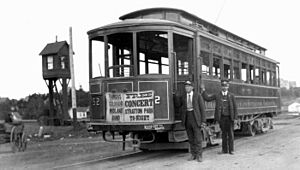
Stratton bought the city's streetcar system. It became known as the Colorado Springs and Interurban Railway. He spent $2 million to make it better. It grew to have 36 miles of tracks and 56 cars. The streetcar line ended at Stratton Park, which Stratton gave to the city. This railway became one of the best streetcar systems in the country.
Stratton also built the first professional baseball stadium in Colorado Springs. The Colorado Springs Millionaires team played there. He also left money in his will to create the Myron Stratton Home. This home was for people in need.
Stratton often gave money to prospectors or others who needed help. He paid for a talented teen violinist to go to school. He even bought bicycles for all the laundresses in town! After a big fire in Cripple Creek in 1896, Stratton paid for food and shelter for many people who lost their homes. He was known for helping people like "Crazy Bob" Womack, who first found gold in Cripple Creek but later had bad luck. He also gave $20,000 to Horace Tabor when Tabor was struggling financially.
Personal Life
Even after becoming very rich, Stratton lived a simple life in a wooden house. He had a short marriage that ended. He was known to be a private person. He enjoyed reading a lot.
Stratton liked a quote from a thinker named William Henry Channing. It talked about living simply, seeking beauty over luxury, and being kind and thoughtful.
Stratton lived at 115 N. Weber St. in Colorado Springs. He had health problems, including liver issues and diabetes. He passed away at his home on September 14, 1902, at 54 years old. More than 8,600 people visited his body before he was buried at Evergreen Cemetery.
Most of his money was used to create and support the Myron Stratton Home. He also left $50,000 to his son, Harry Stratton, and other family members.
Legacy
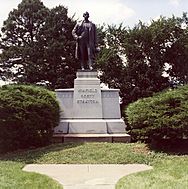
Stratton left most of his money to create the Myron Stratton Home. This home was meant to help "the aged poor and dependent children." It was named after his father, Myron Stratton.
A bronze statue of Stratton, made by Nellie Walker, was placed on the grounds of his estate in 1909.
Another copy of Walker's statue of Stratton stands in downtown Colorado Springs.
Stratton was recognized for his achievements. He was inducted into the National Mining Hall of Fame. In 1967, he was also inducted into the Hall of Great Westerners at the National Cowboy & Western Heritage Museum.
Places Named After Stratton
Many places are named after Winfield Scott Stratton:
- The town of Stratton, Colorado, located in the eastern part of the state.
- Stratton Park in Colorado Springs.
- Stratton Hall at the Colorado School of Mines. This building was finished in 1904. Stratton gave the school its first big gift of $25,000.
- Stratton Spring; a mineral spring in Manitou Springs, Colorado.
- The Winfield Scott Stratton Post Office in Colorado Springs. It was named in 1995. Stratton had sold the land for the post office to the government for a very low price.
- Stratton Elementary School in Colorado Springs.
- Three connected streets in Colorado Springs: Winfield, Scott, and Stratton streets.
In Popular Culture
The actor Gene Evans played Winfield Scott Stratton in a 1964 TV episode. The episode was called "Sixty-seven Miles of Gold" and was part of the show Death Valley Days. In the story, Stratton finds a lot of gold just as he is about to sell his mining claim.


